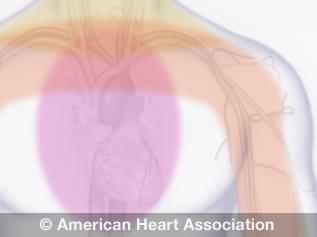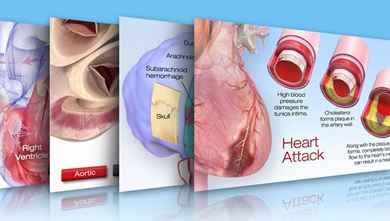Angina (Chest Pain)
Quick Facts
- Angina is chest pain that can spread to other parts of the body.
- It usually happens with physical activity and gets better quickly when you rest.
- It is a symptom of a heart problem.
- Treatments can help reduce pain and lower your risk for heart attack.
Angina is chest pain or discomfort due to your heart muscle not getting enough oxygen-rich blood. It can feel like pressure or squeezing in your chest. It may spread to your shoulders, arms, neck, jaw, abdomen or back. Sometimes, angina feels like an upset stomach. Some people don’t feel pain but have shortness of breath or fatigue.
View an illustration of angina(link opens in new window).
Angina is not a disease. It’s a symptom of a heart problem, usually coronary heart disease. There are different types of angina, including:
Angina usually happens because one or more of the coronary arteries is narrowed or blocked. This is called ischemia.
Angina can also be a symptom of coronary microvascular disease. This heart disease affects the smallest arteries in the heart. It is more likely to affect women than men. Learn more about angina in women.
Understand Your Risk
If you’re at risk for heart disease or coronary artery disease (CAD), you’re also at risk for angina. The major risk factors for angina include:
- Unhealthy cholesterol levels
- High blood pressure
- Anemia
- Heart failure
- Cardiomyopathy
- Metabolic syndrome
- Smoking
- Physical inactivity
- Unhealthy diet
- Job-related stress
- Older age (The risk increases for men after 45 years of age and for women after 55 years of age.)
- Family history of early heart disease
- Heart procedures, including percutaneous coronary intervention (PCI) and coronary artery bypass grafting (CABG)
- Exposure to air pollution
Diagnosis
You should have a health care professional check out all chest pain. They will want to find out if it’s angina. If it is, they will want to know if the angina is stable or unstable. If it’s unstable, you may need emergency medical treatment to try to prevent a heart attack.
Your health care professional will most likely:
- Ask about your symptoms
- Ask about your risk factors for heart disease and other cardiovascular conditions.
- Ask about your family medical history
- Perform a physical exam
Your health care professional will also ask questions to rule out critical or life-threatening causes for your pain. Think ahead so you can give as much information as possible. Some questions you might be asked:
- How long have you had this pain?
- Where is the pain?
- How would you describe the pain?
- On a scale of 1 (mild) to 10 (critical), what is your level of pain?
- What behavior(s) cause the pain? Physical activity? Eating?
- What relieves the pain?
Print our Angina Log to keep track of your angina symptoms.
Your health care professional may recommend the following tests and procedures:
- EKG (Electrocardiogram)
- Stress Test
- Blood Tests
- Chest X-rays
- Coronary Angiography (PDF)
- Computed Tomography Angiography
- Cardiac MRI
Angina Treatment
Angina treatment includes:
- Determining the cause
- Medications to help keep the arteries open, such as nitrates and calcium channel blockers
- Medications to treat other medical conditions and risk factors such as high blood pressure, high cholesterol (including statins) and diabetes
- Cardiac procedures, including PCI and CABG, to open blocked arteries
- Lifestyle changes including healthy diet and physical activity
- Cardiac rehabilitation (if you qualify)
These treatments can reduce pain and reduce how often you have angina pain. They can also lower your risk for heart attack and death by treating any other cardiovascular condition you have.
Other conditions also can cause chest pain, such as:
- Pulmonary embolism (a blockage in a lung artery)
- Aortic dissection (tearing of a major artery)
- A lung infection
- Aortic stenosis (narrowing of the heart’s aortic valve)
- Hypertrophic cardiomyopathy (heart muscle disease)
- Pericarditis (inflammation in the tissues that surround the heart)
- A panic attack
Learn more:
- View a printable sheet: What is Angina? (PDF)







